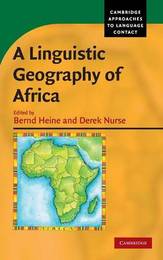
|
A Linguistic Geography of Africa
Hardback
Main Details
| Title |
A Linguistic Geography of Africa
|
| Authors and Contributors |
Edited by Bernd Heine
|
|
Edited by Derek Nurse
|
| Series | Cambridge Approaches to Language Contact |
|---|
| Physical Properties |
| Format:Hardback | | Pages:390 | | Dimensions(mm): Height 230,Width 160 |
|
| Category/Genre | Historical and comparative linguistics |
|---|
| ISBN/Barcode |
9780521876117
|
| Classifications | Dewey:496.09 |
|---|
| Audience | | Professional & Vocational | |
|---|
|
Publishing Details |
| Publisher |
Cambridge University Press
|
| Imprint |
Cambridge University Press
|
| Publication Date |
13 December 2007 |
| Publication Country |
United Kingdom
|
Description
More than forty years ago it was demonstrated that the African continent can be divided into four distinct language families. Research on African languages has accordingly been preoccupied with reconstructing and understanding similarities across these families. This has meant that an interest in other kinds of linguistic relationship, such as whether structural similarities and dissimilarities among African languages are the result of contact between these languages, has never been the subject of major research. This book shows that such similarities across African languages are more common than is widely believed. It provides a broad perspective on Africa as a linguistic area, as well as an analysis of specific linguistic regions. In order to have a better understanding of African languages, their structures, and their history, more information on these contact-induced relationships is essential to understanding Africa's linguistic geography, and to reconstructing its history and prehistory.
Author Biography
Bernd Heine is Professor Emeritus of African Studies at the University of Koln, Germany. Derek Nurse is Henrietta Harvey Research Professor in the Linguistics Department at the Memorial University of Newfoundland, Canada.
ReviewsReview of the hardback: '... it is a data-driven volume written by experienced Africanists with expertise spanning the continent. ... the volume as a whole has the potential to encourage linguists working with apparent genetic units in Africa to consider how areal features contribute to our conceptualisation of 'relatedness' and to re-assess the importance of genetic units in accounting for similarities across languages within a particular geographical area where contact is attested or historically likely.' Journal of Linguistics
|